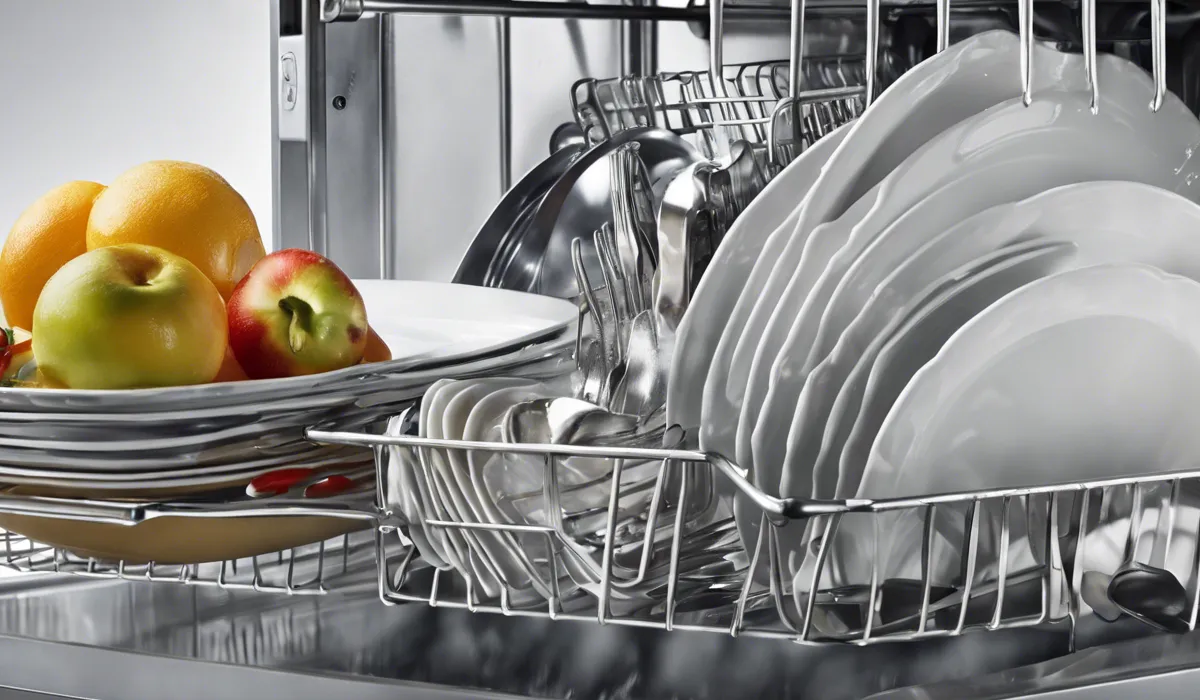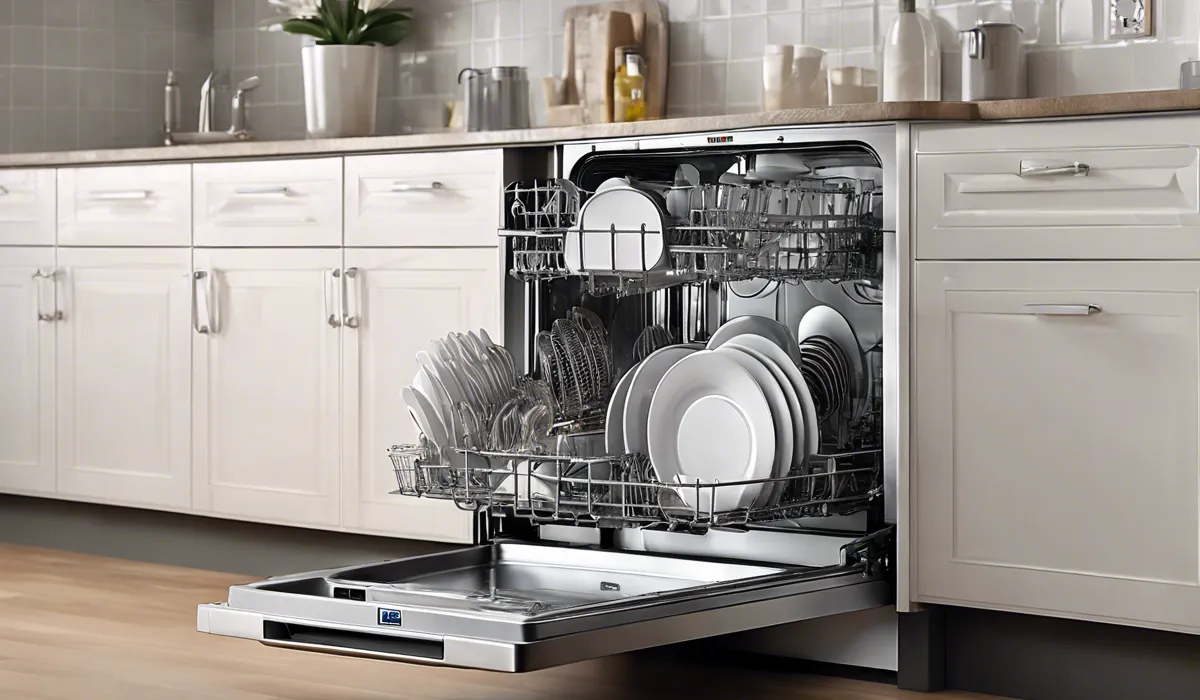How to Use a Dishwasher Properly: Quick & Effective Tips
Load the dishwasher by placing dishes face-down and spaced apart. Add detergent to the dispenser. Choose the appropriate cycle for your load, and start the machine. Ensure to unload the bottom rack first to prevent water drips from the top.
Preparing Your Dishes for the Dishwasher

Scraping off Leftover Food
Before placing your dishes in the dishwasher, it’s crucial to scrape off leftover food. This step prevents food particles from clogging the drain and ensures that your dishwasher can effectively clean your dishes.
Use a rubber spatula or paper towel to wipe away large food scraps into the trash or compost bin. This simple action can significantly improve cleaning results and reduce the risk of future maintenance issues.
Pre-rinsing: When It’s Necessary and When It’s Not
Pre-rinsing dishes is a debated topic. Modern dishwashers are designed to handle a certain amount of food residue, so pre-rinsing every dish under running water is often unnecessary.
However, if you’re not running a cycle immediately or if dishes have dried-on food, a quick rinse can help. Remember, conserving water is key, so use a targeted spray rather than a full sink of water if you must pre-rinse.
The Correct Placement of Dishes in the Dishwasher
Correct placement of dishes maximizes cleaning efficacy. Ensure that dishes face the spray arms and are spaced apart to allow water and detergent to reach every surface.
Avoid nesting bowls or overlapping plates, as this can create shadowed areas where water can’t clean properly. Proper placement also prevents damage to delicate items during the wash cycle.
Loading the Bottom Rack: Pots, Pans, and Plates
The bottom rack of your dishwasher is designed for heavier items like pots, pans, and dinner plates.
Place these items face-down and angled to ensure water can reach all surfaces. For the best results, space out your dishes and avoid placing large items in a way that they block the water from reaching the top rack.
Loading the Top Rack: Glasses, Cups, and Lighter Items
Glasses, cups, and lighter items belong on the top rack. Arrange them between tines, not over them, to prevent water spots and damage.
Lightweight plastics should also be placed on the top rack to avoid the heating element’s direct heat on the bottom, which could cause warping.
Positioning Utensils: The Debate Over Handle Up or Down
Utensils should be loaded in the cutlery basket with some handles up and others down to prevent nesting.
Sharp knives should always have handles up for safety. Mixing the orientation of utensils promotes better cleaning and reduces the risk of injury when unloading.
Ensuring that Spray Arms Can Rotate Freely
Before starting your dishwasher, verify that the spray arms can rotate freely without obstruction.
This step is crucial to ensure water reaches all dishes during the wash cycle. If a piece of cookware or a tall utensil blocks the arm, rearrange your items to clear a path for unrestricted movement.
Selecting the Right Detergent and Cycle Settings

Types of Dishwasher Detergents: Pods, Liquid, Powder
Choosing the right detergent is essential for spotless dishes. Pods are convenient and pre-measured, while powders are cost-effective and adjustable per load.
Liquid detergents are easy to use but may require careful measuring. Select a detergent that works best for your needs and follows the manufacturer’s recommendations for your specific dishwasher model.
The Role of Rinse Aids and Their Benefits
Rinse aids are a key component to achieve streak-free dishes. They work by lowering the surface tension of water, allowing it to spread and evaporate more evenly.
This action helps prevent water spots and enhances drying. If you notice spotting on glassware, adding a rinse aid can make a noticeable difference.
Hard Water Considerations and Detergent Adjustments
If you have hard water, it may be necessary to adjust the amount of detergent you use and consider adding a water softener. Hard water can leave deposits on dishes, but using a slightly higher detergent dose can combat this.
Additionally, some dishwashers have a hard water setting to optimize cleaning in such conditions.
Choosing a Cycle: Eco, Normal, Intensive, and Glass
Selecting the appropriate cycle is crucial for energy efficiency and cleaning performance. Use the eco cycle for lightly soiled dishes to save water and energy.
The normal cycle is suitable for everyday loads, while the intensive cycle tackles heavily soiled items. The glass cycle is designed specifically for delicate glassware and should be used accordingly.
The Importance of Dishwasher Salt in Certain Regions
In regions with hard water, dishwasher salt is a vital addition to prevent limescale buildup and ensure your dishwasher operates efficiently.
The salt regenerates the water softener in the machine, allowing for better cleaning results. Check if your area has hard water and, if so, regularly fill the salt dispenser according to the manufacturer’s instructions.
When to Use Additional Options: Sanitize, High-Temperature Wash, Etc.
Additional options like sanitize and high-temperature wash are available for when you need extra cleaning power.
Use the sanitize option to kill germs on items like cutting boards and baby bottles. The high-temperature wash is great for stubborn food residue but uses more energy, so reserve it for tougher loads.
Maintenance and Troubleshooting

Regular Cleaning of the Filter and Spray Arms
Regular cleaning of the filter and spray arms ensures your dishwasher operates smoothly.
Remove and rinse the filter under running water to remove debris. Check the spray arms for clogs and clear any blockages with a toothpick or small brush. This maintenance helps maintain optimal water flow and cleaning power.
Dealing with Common Issues: Cloudy Glassware, Unclean Dishes, Bad Odors
Cloudy glassware often results from hard water minerals or etching. Adjusting detergent usage or adding a rinse aid can help.
If dishes aren’t coming out clean, ensure that you’re loading the dishwasher correctly and that the spray arms aren’t blocked. Bad odors can be tackled by cleaning the filter and using a dishwasher cleaner or a cup of vinegar in a cycle.
When to Add More Rinse Aid or Salt
Monitor the rinse aid and salt levels regularly, especially if you notice changes in cleaning quality.
Refill the rinse aid dispenser when it runs low, which is typically indicated by a light on the dishwasher’s control panel. Add salt to the softener unit whenever the salt indicator light is on, or as recommended by the manufacturer.
The Importance of Keeping the Dishwasher Seal Clean
The rubber seal around the dishwasher door can harbor food particles and mold. Clean it regularly with a damp cloth to maintain a tight seal and prevent leaks.
This simple step can extend the life of your appliance and ensure it operates at peak efficiency.
How to Unclog a Dishwasher Drain
If your dishwasher isn’t draining properly, it may have a clog. First, check and clean the filter. If the issue persists, inspect the drain hose for kinks or blockages.
You may need to disconnect the hose and flush it with water to clear any clogs. Always consult your dishwasher’s manual before attempting to dismantle parts.
Energy-Saving Tips: Running Full Loads and Using Eco-Mode
To save energy, only run your dishwasher when it’s fully loaded. This practice maximizes efficiency by cleaning more dishes with the same amount of water and energy.
Additionally, take advantage of the eco-mode setting on your dishwasher. This setting uses less water and energy, which is better for the environment and your utility bills.
FAQs About Using a Dishwasher Properly
How should I load the dishes into the dishwasher?
Load dishes face-down and spaced apart to ensure effective cleaning and water circulation.
Where do I add detergent in the dishwasher?
Add detergent to the designated dispenser before starting the dishwasher.
How do I select the appropriate cycle on my dishwasher?
Choose a cycle based on the soil level of your dishes; heavier loads require more intense cycles.
What is the first step after starting the dishwasher?
After choosing the cycle and starting the machine, you can leave it to run until the cycle is complete.
Which rack should I unload first after the dishwasher cycle is finished?
Unload the bottom rack first to prevent water from the top dishes dripping onto the clean dishes below.
Final Thoughts
For proper dishwasher use, arrange dishes face-down and adequately spaced for optimal cleaning. Fill the dispenser with detergent and select the cycle that best fits the nature of your load.
After the cycle, unload the bottom rack first to avoid water from top dishes dripping onto clean items below.





